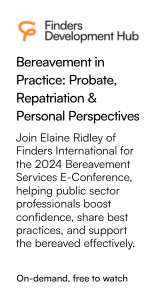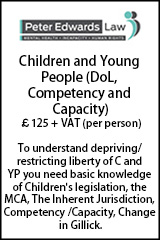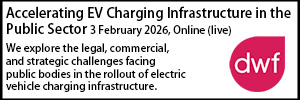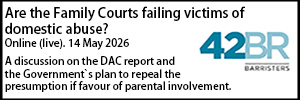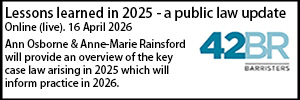Adoption and contact: where do go from here?
- Details
Mark Senior reviews recent developments in relation to adoption and contact, and considers what will happen next.
Three weeks before I was called to the Bar, on 1st July 2002 Sir James Munby, then sitting as a Judge of the Family Division, made an observation which can perhaps be seen as setting the tone for much of the subsequent legal debate about adoption in England and Wales during my career at the Bar.
“…it must never be forgotten that, with the state's abandonment of the right to impose capital sentences, orders of the kind which judges of this Division are typically invited to make in public law proceedings are amongst the most drastic that any judge in any jurisdiction is ever empowered to make. It is a terrible thing to say to any parent – particularly, perhaps, to a mother – that he or she is to lose their child for ever” (Re L (Care Assessment: Fair Trial) [2002] 2 FLR 730 [2002] EWHC 1379 (Fam) [1])
That debate seems to be reaching another interesting moment with the recent publication of the decision of the Court of Appeal in Re R and C (Adoption or Fostering) [2024] EWCA Civ 1302 [2] on 30 October 2024 and the final report of the Public Law Working Group Adoption sub-group “Recommendations for best practice in respect of Adoption” a few days later on 7 November 2024.
Before considering both publications, it may be helpful to provide a brief contextual overview within which their significance can be judged.
Practitioners will need little reminder of the impact that the judgments of the Supreme Court in Re B (Care Proceedings: Appeal) [2013] 2 FLR 1075 [3] and subsequently the Court of Appeal in Re B-S (Children) [2013] EWCA Civ 1146 [4]. That impact can perhaps best be summarised by further observations of Sir James, by now the President of the Family Division, when he said this:
“We have real concerns, shared by other judges, about the recurrent inadequacy of the analysis and reasoning put forward in support of the case for adoption, both in the materials put before the court by the local authorities and guardians and also in too many judgments. This is nothing new. But it is time to call a halt.”
The refinement of the judicial guidance as to how the courts evaluate the evidence in cases involving adoption has continues up to and including Re R and C. Sir James’ term as President came to end and in his place came Sir Andrew Macfarlane, appointed in July 2018.
The year before his elevation to the Presidency, Sir Andrew had delivered the inaugural Bridget Lindley OBE memorial lecture, entitled “Holding the risk: The balance between child protection and the right to family life”. During the course of the lecture, Sir Andrew made the following observations:
“Planning for, building on and supporting contact, possibly with relatives other than those in the immediate centre of the care proceedings, can be very helpful in the long term. It goes without saying, and here I do think that there has been a change, that the need for continuing contact between siblings should be prioritized.
I wonder if, in this regard, the old case law can stand. Is it right that the views of the adopters should hold such sway?...”
The answer to this latter question came relatively early in Sir Andrew’s tenure, in the case of Re B ( A Child: Post Adoption Contact) [2019]EWCA Civ 29 [5]. Delivering the lead judgment, the President firmly slammed the door shut on any hopes that this was to be the case in which the “winds of change” carried a new approach to the primacy of the adopters wishes:
52. “The starting point for any consideration of this issue must be the settled position in law had been reached by the decision in Re R, which was confirmed by this court in the Oxfordshire case and in Re T. The judgment in Re R was, itself, on all fours, so far as imposing contact on unwilling adopters, with the position described by Lord Ackner in Re C.
53. As stated by Wall LJ in Re R, prior to the introduction of ACA 2002, s 51A, the position in law was, therefore, that "the imposition on prospective adopters of orders for contact with which they are not in agreement is extremely, and remains extremely, unusual."
54. Although s 51A has introduced a bespoke statutory regime for the regulation of post adoption contact following placement for adoption by an adoption agency, there is nothing to be found in the wording of s 51A or of s 51B which indicates any variation in the approach to be taken to the imposition of an order for contact upon adopters who are unwilling to accept it. Indeed, as Mr Goodwin's submissions, in my view, establish, both the Explanatory Note and the fact that Parliament only afforded the court power to make orders of its own motion if such orders are to prohibit contact, Parliament's intention in enacting s 51A was aimed at enhancing the position of adopters rather than the contrary…”
His Lordship’s judgment concluded with the following observations, which we will see have reverberated to the present time:
61. “Post-adoption contact is an important issue which should be given full consideration in every case [ACA 2002, s 46(6)]. Whilst there may not have been a change in the law insofar as the imposition of a contact regime against the wishes of prospective adopters is concerned, there is now a joined-up regime contained within the ACA 2002 for the consideration of contact both at the placement for adoption stage and later at the hearing of an adoption application. Further, and in contrast to the situation prior to 2014 where the issue of contact on adoption was determined under s 8 by applying the CA 1989, s 1 welfare provisions, issues under both s 26 and s 51A of the ACA 2002 will be determined by applying the bespoke adoption welfare provisions in ACA 2002, s 1, where the focus is not just upon the welfare of the subject of the application during childhood but throughout their life.
62. A placement for adoption hearing has the potential for having an important influence upon the development of any subsequent long-term contact arrangements. As required by ACA 2002, s 27(4), the court must consider the issue of contact and any plans for contact before making a placement for adoption order. The court's order may well, therefore, set the tone for future contact, but the court must be plain that, as the law stands, whilst there may be justification in considering some form of direct contact, the ultimate decision as to what contact is to take place is for the adopters and that the court will be 'extremely unusual' for the court to impose a contrary arrangement against the wishes of adopters.”
Plus ça change, one might say. However, over the course of the last twelve months, the President has returned to similar themes over the course of two lectures - the Mayflower lecture “Adapting Adoption to the Modern World” (November 2023) [6] and the POTATO lecture “Adapting Adoption to the Modern World: Part Two” (May 2024) [7]. (These lectures followed on from lectures in 2017 and 2019 where the President had raised the need for greater understanding of the potential benefits of contact between adopted children and members of their birth family.) Whilst both recent lectures are required reading for practitioners in this area, the following excerpt from part two demonstrates that the President sees the value in what he describes as “quite a radical change”:
“Drawing this strand together, if there is to be a culture change with regard to future family contact, then, as part of that culture change, it is likely that the almost absolute autonomy currently afforded by the courts to the adopters in matters of contact will have to be reviewed…
Rather than fix the contact arrangements, once and for all, on the making ofthe adoption order, isn’t there real value in there being a formal review of contact with the birth family some two or more years later? By that time parents or other family members may have come to accept the situation and be more available, in emotional terms, to support the child in their adoptive home. The adopters will know their child well and may themselves feel more confident and secure in their role, and therefore more able to contemplate a greater degree of contact. The child will also be that bit older and may express clear views on the topic.”
The President’s observations were heard loud and clear by Lord Justice Baker, who delivered the leading judgment in Re R and C. The appeal concerned a judge's refusal to make placement orders in respect of two young children. The principal reason for the judge's decision was that he concluded that adoption was inconsistent with the children's need for continuing contact with members of their birth family, in particular their two elder half-siblings.
His Lordship’s judgment begins with an aside which might be seen as striking a rather different tone from that which concluded the judgment five years ago in Re B:
2. “This appeal falls to be decided at a time when there is renewed discussion about open adoption and provides an opportunity to reiterate the clear principle that, at the stage of making an order under s.21 of the Adoption and Children Act 2002 authorising a local authority to place a child for adoption, it is the court, rather than the local authority or any other person, which has the responsibility for determining whether there should be ongoing contact between the child and the birth family.” (emphasis added)
The inevitably lengthy summary of the relevant case law included a decision post Re B, Re T and R (Children: Refusal of Placement Orders) [2021] EWCA Civ 71 [8] in which the Court of Appeal had upheld a decision to refuse a placement order in quite distinctive factual circumstances in which the cultural identity of the subject children demanded continuing contact which, as the Court of Appeal held, the trial judge was entitled to conclude would be difficult to guarantee.
His Lordship also, unsurprisingly, made specific reference to the lectures of the President referred to above, and in particular two passages which chime with his observations at paragraph 2 above:
39. “In the course of his second lecture, the President took the opportunity to underline some features of the existing law and also make suggestions about how the law might develop in future. He observed:
"Orders for contact made under ACA 2002, s 26 when making a placement for adoption order set the template for contact going forward. Where continuing contact in some form is ordered at that stage, this will be an important 'known known' about the child to be taken on board by any potential adopters with whom placement may be considered."
He continued:
"…the likely template for contact arrangements post adoption should be set at the placement order stage. This is not a change in the current approach. A court making a s.26 contact order, in keeping with the duty under s.1 and its lifelong focus, should have regard not only to the short-term contact arrangements required in the pre-adoption stage, but also in setting the course for the maintenance of family relations over the longer term if that is in the child's best interests. Also, there is nothing wrong, and I would suggest it should be good practice, for a s.26 contact order to contain a recital as to the court's view on contact arrangements post adoption."
40. In these observations, the President was doing no more than reiterating the approach to s.26 mandated by case law…”
Pausing for a moment, it may be that my experience is unduly limited, but until post the Mayflower lecture I had not heard of any case in which a trial Judge had considered the making of an order under section 26. When issues of post adoption contact were raised in cross examination, they were routinely met with the argument that the consideration of such matters was likely to reduce the pool of potentially available adoptive placements and the importance of the stability of an adoptive placement had to come before the need for contact. Such arguments were routinely accepted by Judges and found their way into subsequent judgments.
In that context, it is perhaps not surprising, as Baker LJ records, that the trial Judge had as “A key element in the judge's reasoning was his assertion that "permanence comes at a significant cost, namely the complete and irrevocable severance of all ties with the natural family””. The learned trial Judge might perhaps be forgiven for being surprised at what follows in His Lordship’s judgement:
“…As demonstrated by the summary of the case law set out above, that may have been true of all adoptions at one stage, and it remains true of some adoptions now. But it is emphatically not true of many adoptions and is at odds with the concept of open adoption which is now embraced as a model in what the President has called the modern world. The judge acknowledged that the severance of ties with the natural family "can sometimes be ameliorated by continued contact between the birth family and the adopted child" and that, in this case, the local authority has "committed itself to a search only for adopters willing to promote direct sibling contact". He discounted these factors, however, on the basis that ongoing contact "is at the discretion of the adopters" and that "sibling contact cannot be guaranteed" because "even adopters who are open to it initially may not continue to promote it after the making of an adoption order".
66. In these observations, the judge overlooked the fact that it was his duty to "set the template for contact going forward". This case seems to fall four square within the words used by Wall LJ in Re P at paragraph 151. As in that case, there is a "universal recognition" that the relationship between the siblings needs to be preserved. It is "on this basis that the local authority / adoption agency is seeking the placement of the children …. [T]his means that the question of contact between the two children is not a matter for agreement between the local authority / adoption agency and the adopters: it is a matter which, ultimately, is for the court". In those circumstances, "it is the court which has the responsibility to make orders for contact if they are required in the interests of the two children".
As to how that fits the reaffirmation of the importance, if not primacy, of adopters wishes from Re B, His Lordship makes the following observations:
67. “Under the current law, as the President said in Re B, "it will only be in an extremely unusual case that a court will make an order stipulating contact arrangement to which the adopters do not agree". But that does not obviate the court's responsibility to set the template for contact at the placement order stage. In this case, the local authority was committed to search only for adopters willing to accommodate sibling contact and invited the court to make an order for contact under s.26, both to meet the children's short-term needs and to set the template. There was of course a possibility that the search for such adopters might be unsuccessful or that adopters might subsequently refuse to agree to contact. But in the circumstances of this case, that possibility was not a sufficient reason to refuse to make the placement order.” (emphasis added)
On this basis although the trial Judge had (again, perhaps understandably) relied on the decision in Re R and T referred to above, Baker LJ ( who had given the leading judgment in that decision) concluded that he had been wrong to do so.
68. “In reaching his conclusion, the judge quoted passages from my judgment in Re T and R. It does not follow, however, that in every case where the court concludes that it is strongly in the interests of the children to continue to have sibling contact the option of adoption should be ruled out. Each case turns on its own facts. In Re T and R¸ the crucial importance of contact to the psychological wellbeing of the subject children and their older siblings, the importance of maintaining the children's sense of their cultural and community heritage, which could only be achieved through contact, coupled with the community's antipathy to adoption which made contact unfeasible, led to a conclusion that adoption was not in the interests of the children's welfare. In other cases, the evidence will clearly demonstrate not only that ongoing sibling contact is in the children's interests but also that it is likely to be achievable in an adoptive placement. In my view, this is just such a case.”
An interesting factual element of this appeal was that the local authority was explicitly committed to only placing the children with prospective adopters who would facilitate sibling contact as the care plan provided for. It is this fact particularly perhaps that allowed His Lordship to undertake his own holistic analysis of the options and conclude that this was, in fact, a case in which the best of both worlds was achievable.
Apart from being a timely reminder to us all never to assume we know what the Court of Appeal will think on any given issue, what is perhaps the most noteworthy aspect is the almost causal conclusion by which, as far as I am aware, the Court of Appeal for the first time makes an order for contact under section 26 of the 2002 Act:
92. “If my Ladies agree, I would therefore propose that this Court allows the local authority's appeal, sets aside the judge's order, and makes placement orders in respect of both children. In addition, pursuant to s.26(2)(b) of the 2002 Act, I would add an order requiring the person(s) with whom R and C live, and any other person(s) with whom they are to live while they remain the subjects of placement orders, to allow them to attend visiting contact with their siblings N and Y six times per year, in accordance with arrangements made by the local authority. I would include in the order a recital, in terms proposed by the local authority, recording that
"the local authority confirming that, under its care plans and during its search for prospective adopters for R and C
(1) that the local authority will arrange direct inter-sibling contact between the subject children and their siblings N and Y, six times per year;
(2) that the local authority will search exclusively for and will match the subject children only with prospective adopters committed to facilitating inter-sibling contact as set out above and who will propose to adopt both the subject children;
(3) that, in the event that prospective adopters committed to facilitating inter-sibling contact as set out above have not been found within six months, the local authority will apply to the court."
93. Finally, in line with the suggestion made by the President in his second lecture "Adapting Adoption to the Modern World – Part Two" (quoted at paragraph 39 above), I would propose adding a recital that it is this Court's view that after adoption R and C should continue to have direct contact with N and Y six times a year.”
As for the President’s observations about the advantages of reviewing contact further down the line, Baker LJ offers up something for anyone interested in spotting the potential for landmark cases:
41. “In these observations, the President was doing no more than reiterating the approach to s.26 mandated by case law. He went on to express some preliminary thoughts about how courts might in future exercise their powers to make contact orders at the adoption application stage. As he acknowledged, in those remarks he was considering steps which go beyond the current case law. It is likely that this Court will consider these matters again at some point, but they do not arise on this appeal. We are concerned only with the interpretation of s.26…”
When we were all just starting to recover from a section 26 order from the Court of Appeal, the final report from the PLWG adoption sub-group arrives in our inboxes9. The interim report, published shortly before the Mayflower Lecture, gave a strong indication what to expect, and the final report comes as no surprise:
71. There needs to be a sea change in the approach to the question of face-to-face contact between the adopted child and the birth family or other significant individuals. Greater consideration needs to be given, throughout the child’s minority, as to whether they should have face to face contact with those who were significant to them before they were adopted. It is recognised that this will not be safe for all adopted children, but the current system whereby face-to-face contact is the exception rather than the rule is outdated.” (emphasis added)
The report also notes the conclusions of the House of Lords Children and Families Act 2014 Committee (which reported in December 2022) that “Contact, where safe, appropriate and properly managed, can be valuable for an adoptive child, their new family and their birth family, including siblings and other relatives. However, contact orders and support can vary, and the current system of letterbox contact is outdated. The failure to modernise contact threatens to undermine the adoption system”. (emphasis added)
Space prevents a detailed summary of the recommendations, but it seems clear that the “sea change” that the President was talking about appears to be very much still on the agenda. When one considers that a) in Northern Ireland ( as mentioned in the final report) continuing direct contact post adoption happens more often than not, and b) in some states of Australia post adoption contact is enshrined in statute , it is perhaps no surprise that the drive to more openness continues.
At the heart of the proposals is a clearly identified need for (a) consistent training for adopters placing at its core the lifelong adoption related needs of adopted people “in relation to their sense of identity and loss in respect of birth family connections and the importance of open communication and birth family contact (direct and indirect) in helping to meet those needs; and (b) training for social work professionals and lawyers as to the benefits of open adoption such training to include the research outcomes of post adoption contact. Early identification of those who are or may be important to a child including siblings, wider family and potentially those who are not related, should take place using an eco-map for ‘important relationships’.
There is a clear recommendation that the full range of contact options (including digital options) are given “active consideration” during the care and placement proceedings, with a renewed emphasis on post-adoption contact in the final care plan including the support that might be required for the child, prospective adopters and the identified birth family member to enable contact to be safe and meaningful. Orders pursuant to s.26 ACA 2002 can be used to “set the tone” for what may happen after the adoption order, as identified by Professor Beth Neil, “Such orders may influence the search for adopters and focus the minds of professionals, prospective adopters and birth relatives on establishing a working contact plan. This may be a useful tool where children are considered to have a compelling need for ongoing contact, helping to avoid these needs being side-lined in order to make him or her more ‘adoptable’, an outcome that is incompatible with the notion of adoption as a service for children.” (emphasis added)
It remains to be seen what the judicial approach will be in a case involving an evidenced need for continued contact and prospective adopters unwilling to countenance this. The final report of PLWG rightly emphasises the importance of support and training. This writer’s recent professional experience of support available in this area to facilitate ongoing contact leaves him skeptical as to whether resources will readily be available to turn the bold thinking into positive outcomes.
Mark Senior is a barrister at St John’s Buildings.
[1] https://www.bailii.org/ew/cases/EWHC/Fam/2002/1379.html
[2] https://www.bailii.org/ew/cases/EWCA/Civ/2024/1302.html
[3] https://www.supremecourt.uk/cases/docs/uksc-2013-0022-judgment.pdf
[4] https://www.judiciary.uk/wp-content/uploads/JCO/Documents/Judgments/b-s-children.pdf
[5] B (A Child : Post-Adoption Contact) [2019] EWCA Civ 29 (30 January 2019)
[6] https://www.judiciary.uk/speech-by-sir-andrew-mcfarlane-adapting-adoption-to-the-modern-world/
[7] https://www.judiciary.uk/wp-content/uploads/2024/05/Keynote-Address-Sir-Andrew-McFarlane-Potato Conference-2024.pdf
[8] T and R, Re (Refusal of Placement Order) [2021] EWCA Civ 71 (28 January 2021)
Thank you to Kate Burnell KC for her helpful comments and suggestions on this article.
























